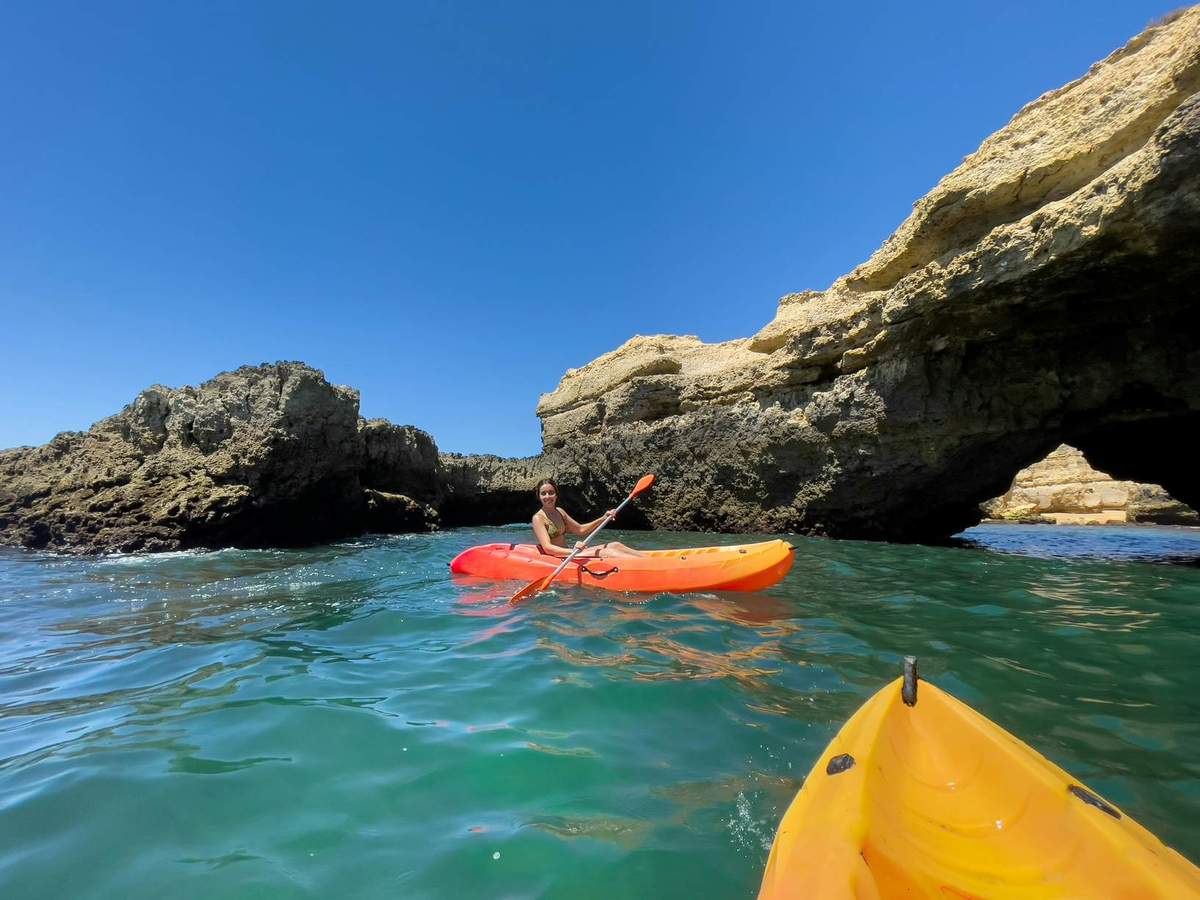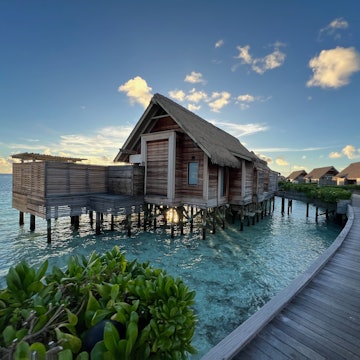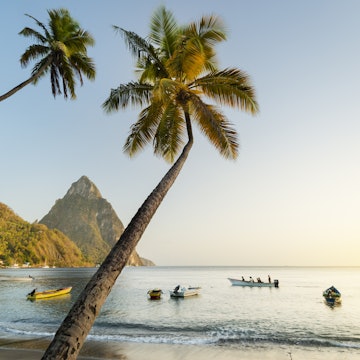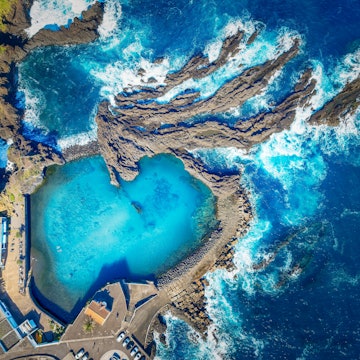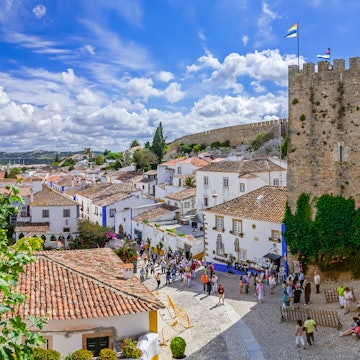
The best road trips in the Algarve to escape the crowds

Aug 5, 2025 • 10 min read

A road trip in the Algarve means dramatic scenery, both inland and along the coast. FranciscoMarques/Shutterstock
There’s a lot to love about road trips in the Algarve. Be it sunny days driving to secluded surf beaches cooled by an Atlantic window breeze, or curving citrus-scented streets towards the serras (mountain ranges) with a birdsong soundtrack, every dirt track detour and narrow country road will bring you closer to a less-crowded, calmer Algarve.
Sure, trains trundle between the south coast’s main towns, and limited buses link beaches and whitewashed villages, but to explore beyond the main resorts or maximize your time, four wheels are your best bet. Just don’t arrive expecting a long, continuous coastal drive; between most beach towns, you’ll need to zip slightly inland.
Best of all? Portugal’s sunny southern region is pretty compact. Crossing the breadth of the Algarve, from the Spanish border to mainland Europe's southwesternmost point, takes merely two hours on the now toll-free A22, meaning with a week in the Algarve, you can string together a couple of our recommended road trips and still slow down to savor the journey.

1. Chase waves on the Costa Vicentina’s wild west coast
Best for surf, secluded sands, and stellar ocean views
Start/Finish: Lagos–Odeceixe
Approximate distance: 128km (80 miles); Allow 1–3 days
Although best known for its long-distance hiking trails, a road trip of the surf-pounded and all-round sensational Costa Vicentina – arguably the Algarve’s finest nature reserve – affords a one-day introduction to the park’s highlights, or a slower sojourn between hard-to-access bays, edge-of-Europe lighthouses, and Moorish landmarks. It’s also the driving route with the most coastal vistas.
Leaving Lagos, you’ll soon swing back towards the coast to pass a trio of laid-back, whitewashed villages: Praia da Luz, Burgau – stop for breakfast pastries at Os Amigos and appreciate the fetching bouganvillea-draped, blue-hemmed buildings – and Salema, where dinosaur prints are imprinted in the beach’s rocks. In Sagres, spend a couple of hours visiting the “Age of Discovery” exhibition in the imposing Fortaleza de Sagres and mainland Europe’s southwesternmost point, the wind-whipped Cabo do São Vicentina headland. A Sereia is the place for a fresh fish feast while overlooking the afternoon seafood auction.
Driving north, bumpy road detours lead to a succession of secluded cliff-wrapped beaches and bays popular with surfers. Pick any and you’ll be swooning, but untouched Praia da Barriga and river-wrapped Praia da Amoreira are personal favorites. The best stretch of coastal drive follows Pontal da Carrapateira Trail’s gravel tracks between surf-friendly Praia do Amado and dune-backed Praia da Bordeira, with leg-stretching stops at Islamic ruins and boardwalks. After an amble around Aljezur’s Moorish castle ruins, end the day paddling at Praia de Odeceixe.
Detour: If you’re returning to Lisbon, or simply don’t want the shoreline scenery to end, cross the bridge into the Alentejo region and the second half of the Parque Natural do Sudoeste Alentejano e Costa Vicentina. Gorgeous beaches abound, especially around Vila Nova de Milfontes and Porto Covo. Even if you return to the Algarve, it only adds a few hours of driving time.

2. The Algarve’s classic central coast drive
Best for famous beaches and top attractions
Start/Finish: Faro–Lagos
Approximate distance: 147km (91 miles); Allow 3–4 days
Covering many top attractions, resort towns and famous beaches, the headliners along this route are easily visited by public transport. Make the most of having a car and take advantage of the less scenic but necessary N125 inland detours by incorporating otherwise hard-to-reach spots.
After touring Faro’s highlights, call at São Lourenço Church, a small but striking church decked with blue and white azulejos (hand-painted tiles), before a first swim on Praia da Falésia, Albufeira’s award-winning beach backed by ochre-hued cliffs. Stroll the old town, or continue to Praia de São Rafael to hike the cliffs between hidden coves. Back on the N125, dine at Ramires in Guia – the reported birthplace of chicken piri-piri – and visit Porches Pottery, one of the Algarve’s oldest studios, for ceramic souvenirs. Nearby, two of the Algarve’s most famous attractions await: the dramatic rock formations of Praia da Marinha and kayak trips to the Benagil Cave.
Continue to Carvoeiro, or beach-hop along the spectacular Seven Hanging Valleys Trail to stretch your legs, to see the wave-chiseled Algar Seco rock formations, followed by lunch in the pretty fishing village of Ferragudo. Across the estuary, the modern Museu de Portimão affords excellent insight into the old sardine industry. Trace the almost coastal road from Praia da Rocha to Alvor to spot flamingos in the lagoon. Oyster fan? Give OstraSelect a call and stop to collect a freshly harvested bag en route to Lagos’ Meia Praia. Skirt the town to end at Ponta da Piedade, peering down on the dramatic sandstone towers from the breezy boardwalks.
Local Tip: Parking at popular beaches and Benagil can be challenging in the summer. Consider spending the night nearby and joining an early morning boat or kayak tour for a calmer experience; in 2024, restrictions banned unguided visits.

3. An introduction to the interior’s wineries, makers and mountains
Best for viewpoints and vineyards
Start/Finish: Lagoa–Monchique
Approximate distance: 113km (70 miles); Allow 1 day
Leave the coast behind on this picturesque drive through citrus groves and vineyards into the Serra de Monchique, to meet local makers and find tranquility in the mountains. From Lagoa (inland from Carvoeiro), the drive to castle-crowned Silves passes a handful of the region’s finest wineries; if you’ve a designated driver, stop for a tasting. Take the main road to Morgado do Quintão, where you can sip under an ancient olive tree, or detour via Estômbar on a more bucolic drive for Adgea Arvad’s scenic river view tastings of Phoenician-style amphora produced vinhos. Plan a couple of hours ambling around fetching Silves, the former medieval, Moorish capital of the Algarve, admiring Islamic artifacts at the Museu Municipal de Arqueologia and surveying it all from the castle’s hulking sandstone walls.
Drive around the back of the castle for a traditional lunch at Recanto Dos Mouros, then track countryside ER124 into the serra. At Caldas de Monchique, a whimsical thermal spa village – pre-book treatments or spend the night – enjoy a shaded walk alongside once Roman-revered springs, followed by another leg stretch on the Passadiços Barranco do Demo, a 1km boardwalk and suspension bridge over a verdant valley. In Monchique town, browse the unique ceramics in Studio Bongard’s garden, before finishing in Fóia, the Algarve’s highest peak at 902m (2959ft). The food truck’s deckchairs are a perfect sunset drink spot, the ocean sparkling in the distance.
Detour: From Fóia, it’s a 20-minute drive to Marmelete, a teeny village renowned for its centuries-old production of fiery aguardente de medronho. Casa do Medronho explains the process, and with prior arrangement, you can spend a wholesome hour or two picking fruit and witnessing the distillation process in local homes.
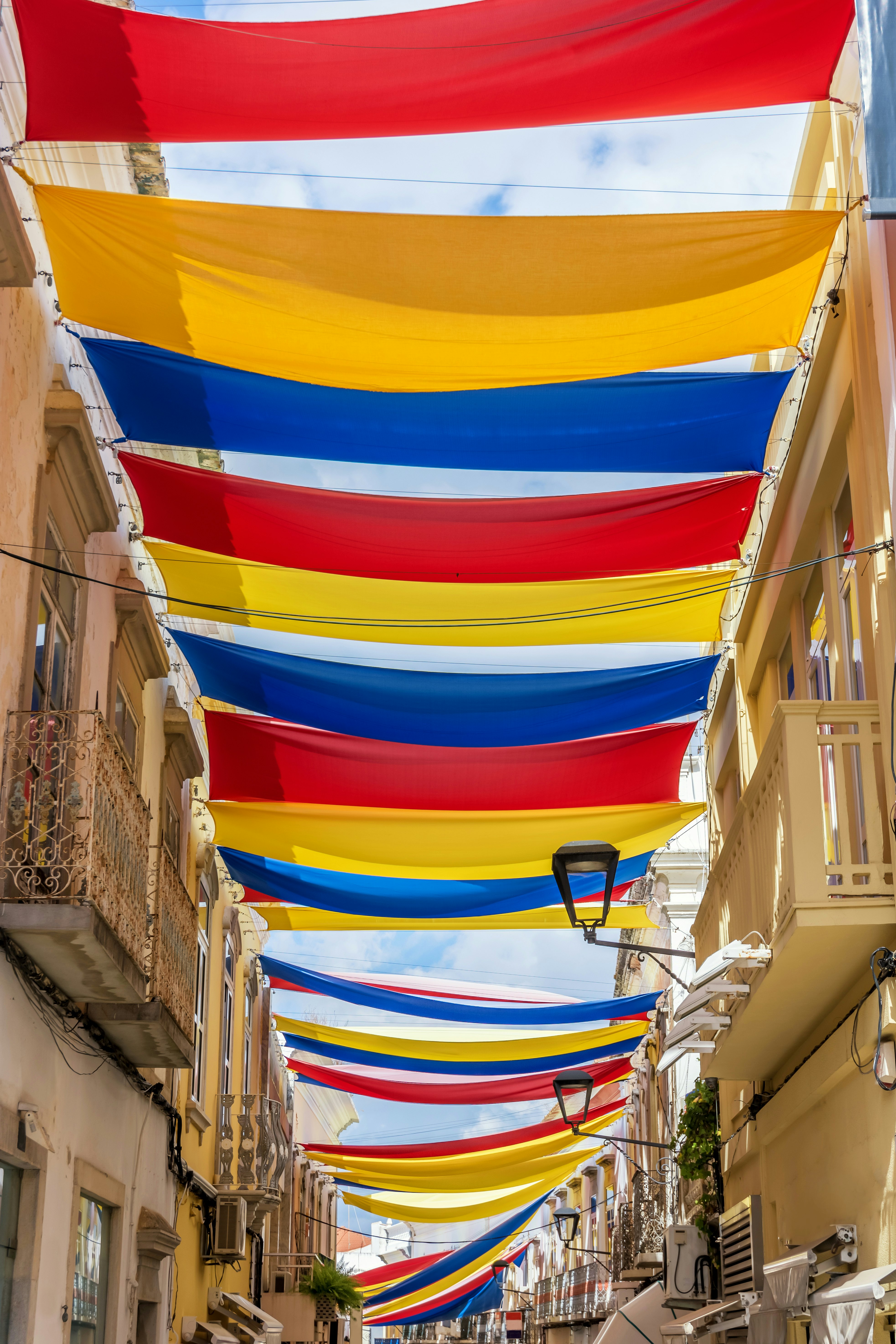
4. The quintessential crafts, cork, villages and waterfalls route
Best for handsome hamlets and homespun traditions
Start/Finish: Faro–Alte
Approximate distance: 89km (55 miles); Allow 2–3 days
Venture into the Algarve’s hinterlands around the Serra do Caldeirão and you’ll still find ancestral crafts, time-worn villages and a few surprises in the rugged hills. First stop is Estoi, for vast Roman villa ruins and the well-manicured gardens of the 18th-century Palácio de Estoi (now a hotel). Briefly join the N2, Portugal’s most famous road trip linking north to south, until the cork countryside surrounding São Brás de Alportel. Learn about cork production on a morning tour at Eco-fábrica de Cortiça, or visit Museu do Traje, a fascinating collection of typical 19th-century Algarvian outfits displayed in a former cork tycoon’s mansion. After an old Roman road amble, head to Loulé for the night.
Start early at the neo-Moorish Loulé Market, the Algarve’s largest, before touring the six free-to-visit workshops spread across town, each spotlighting a different ancestral craft, from palm weaving to hammering copper into the region's ubiquitous cataplana cooking pot. In the afternoon, drive between a cluster of teeny, whitewashed villages: Querença, Tôr – home to a reconstructed medieval bridge and winery – and Salir, complete with the ruins of a 12th-century castle. Before arriving in Alte, arguably the Algarve’s most adorable village, detour high into the hills to take in a prayer flag-fluttering panorama from a somewhat unexpected Buddhist Stupa. End the day splashing in Alte’s Queda do Vigário waterfall and fontes (streams), followed by a sunset dinner on O Folclore’s hidden rear balcony overlooking citrus groves.
Local Tip: Many museums close on weekends; plan your drive between Tuesday and Friday for the best experience. In summer, Alte’s waterfall can be a trickle due to droughts.
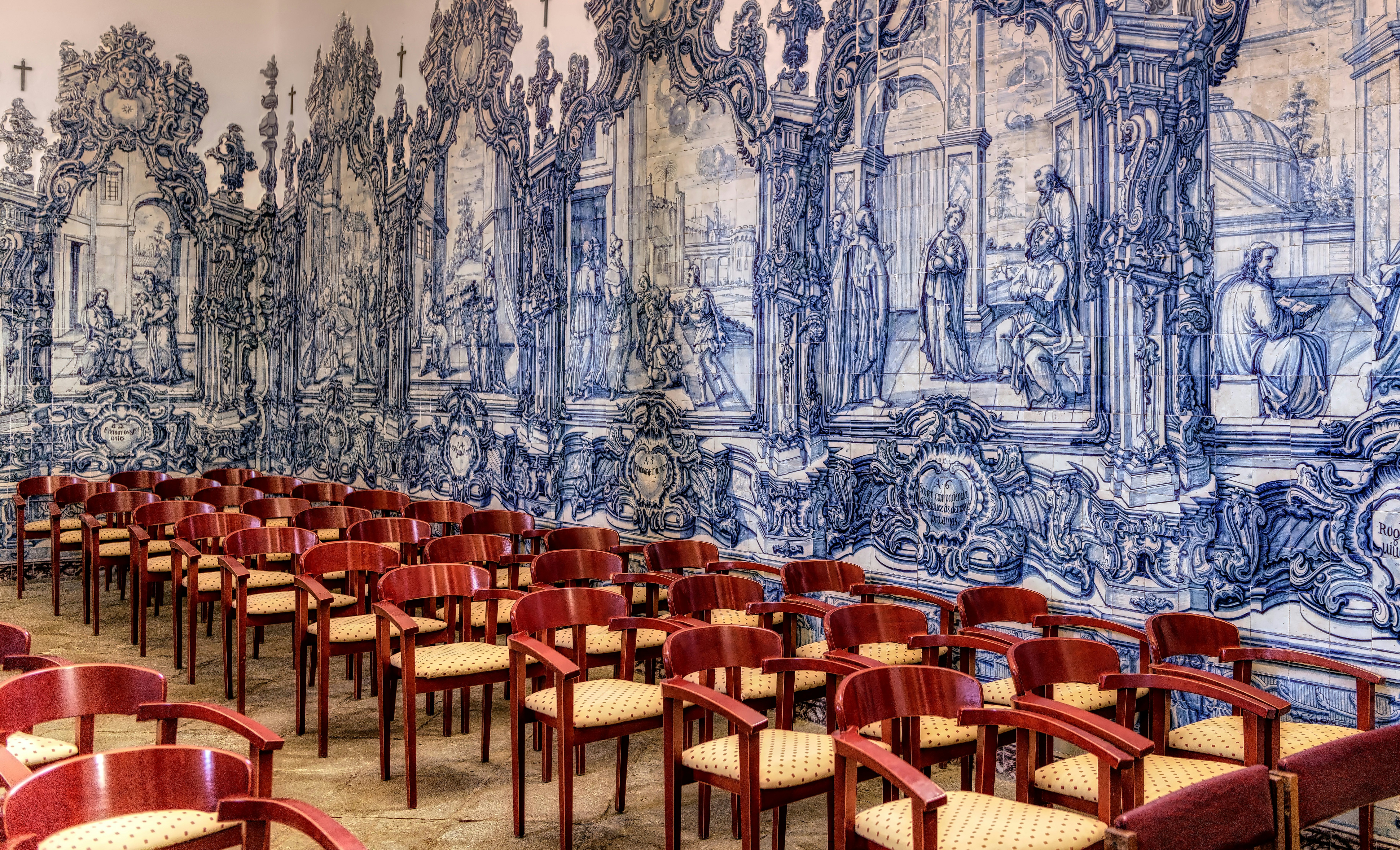
5. Explore the eastern Algarve
Best for a well-rounded Algarvian experience
Start/Finish: Faro–Vila Real de Santo António
Approximate distance: 80km (50 miles); allow 2–3 days
The eastern Algarve has developed at a different pace, affording a road trip more about historic sights and culinary traditions than craggy beaches, though glorious sandy islands more than compensate. Dart to coastal Olhão, a fishing town with a prized seafood market (arrive before noon to see the action) and after lunch, take a ferry to the Parque Natural da Ria Formosa’s barrier islands for a lazy afternoon. Back behind the wheel, drive for dinner in Santa Luzia, renowned for its polvo (octopus), before spending a night in Tavira.
Once the Algarve’s most populated town, river-flanking Tavira is incredibly photogenic and layered in history. Visit a few of the 30-odd churches – tile-bedazzled Igreja da Misericórdia is the centrepiece – see Moorish artifacts in the Núcleo Islâmico, and stand atop the crenellated walls of the ruined castle. After lunch and a Fado performance, drive out to Quatro Águas’ salinas (salt pans) to hopefully spot flamingos. To the east, there are a handful of unfussy beach towns to choose from before Vila Real de Santo António – the standout is Cacela Velha, a diminutive, cobblestoned village perched on a cliff above a cyan-swirling beach.
Detour: For an authentic taste of the Algarve, pre-book a tour of the Monterosa olive oil estate as your first stop before arriving in Olhão, or a cooking class with dinner at Monte do Álamo outside Tavira.

6. Trace the Guadiana River’s smuggling stories
Best for hushed history
Start/Finish: Vila Real de Santo António–Alcoutim
Approximate distance: 48km (30 miles); allow 1 day
Loosely tracking the border-defining Guadiana, this one-day drive spotlights Spanish frontier stories, from defensive castles to smuggling routes. Setting off from Vila Real de Santo António, a handsome, compact city rebuilt in the 18th century using Pombaline elements of post-earthquake Lisbon, stop at the Reserva Natural do Sapal de Castro Marim e Vila Real de Santo António. There are some excellent birdwatching trails in the salinas, alongside seasonal mud spas at Agua Maé and the chance to try traditional salt harvesting at Sal Marim (pre-book). Surveying it all is Casto Marim’s 13th-century castle; tucked inside the outer walls is another four-towered castle, now a torture museum.
At the Barragem de Odeleite – known as the Blue Dragon River due to its aerial appearance – turn onto the EM1063 for a mostly river-hugging drive. Highlights are the museum, dedicated to the contraband trade during the 1936 Spanish Civil War, and some low-walled Roman ruins. In Alcoutim, the Algarve’s least populated town, life is delightfully unhurried – unless it’s the three-day, biannual Festival do Contrabando (next hosted in spring 2027) when a floating bridge links its Spanish counterpart. Poke around the 14th-century castle turned archaeological museum, drive out to the even older castle ruins, and finish at the Fluvial do Pego Fundo’s river beach bar.
Detour: Pop to Spain without the hassle of driving. Ferries depart Vila Real de Santo António to Ayamonte, or take a kayak or boat from Alcoutim to Sanlúcar de Guadiana – you could even return on the world’s only cross-border zipline.
Tips for driving in the Algarve
Some international drivers don’t require an IDP for Portugal, but they do in Spain; check in advance if you plan to cross the border.
The Algarve’s toll road charges were suspended in 2025, but continue in other parts of Portugal. As such, most rentals will still require you to pay for an electronic toll transponder when collecting your car.
EV charging stations are limited inland; plan your charging stops in advance.
Take the GPS with a pinch of salt. Most maps suggest quicker, rather than scenic, routes, and journey times are usually over-optimistic on the narrow countryside 90km/h roads, where, in reality, you’ll rarely come close to those speeds, though some local drivers certainly try.





